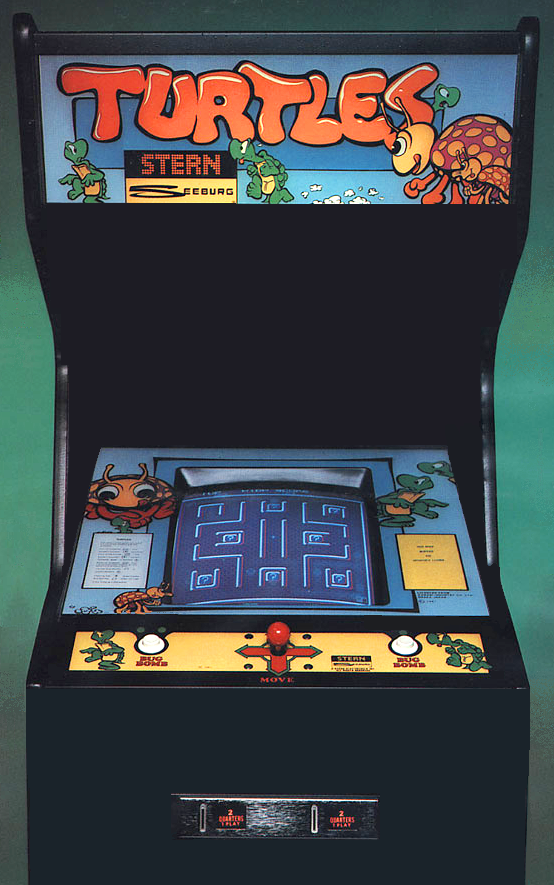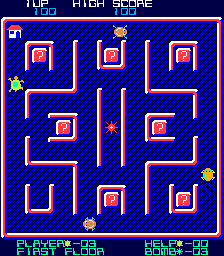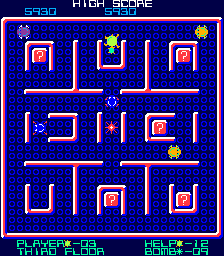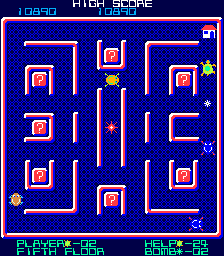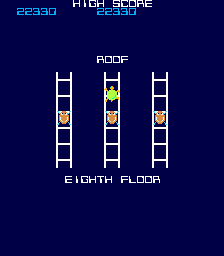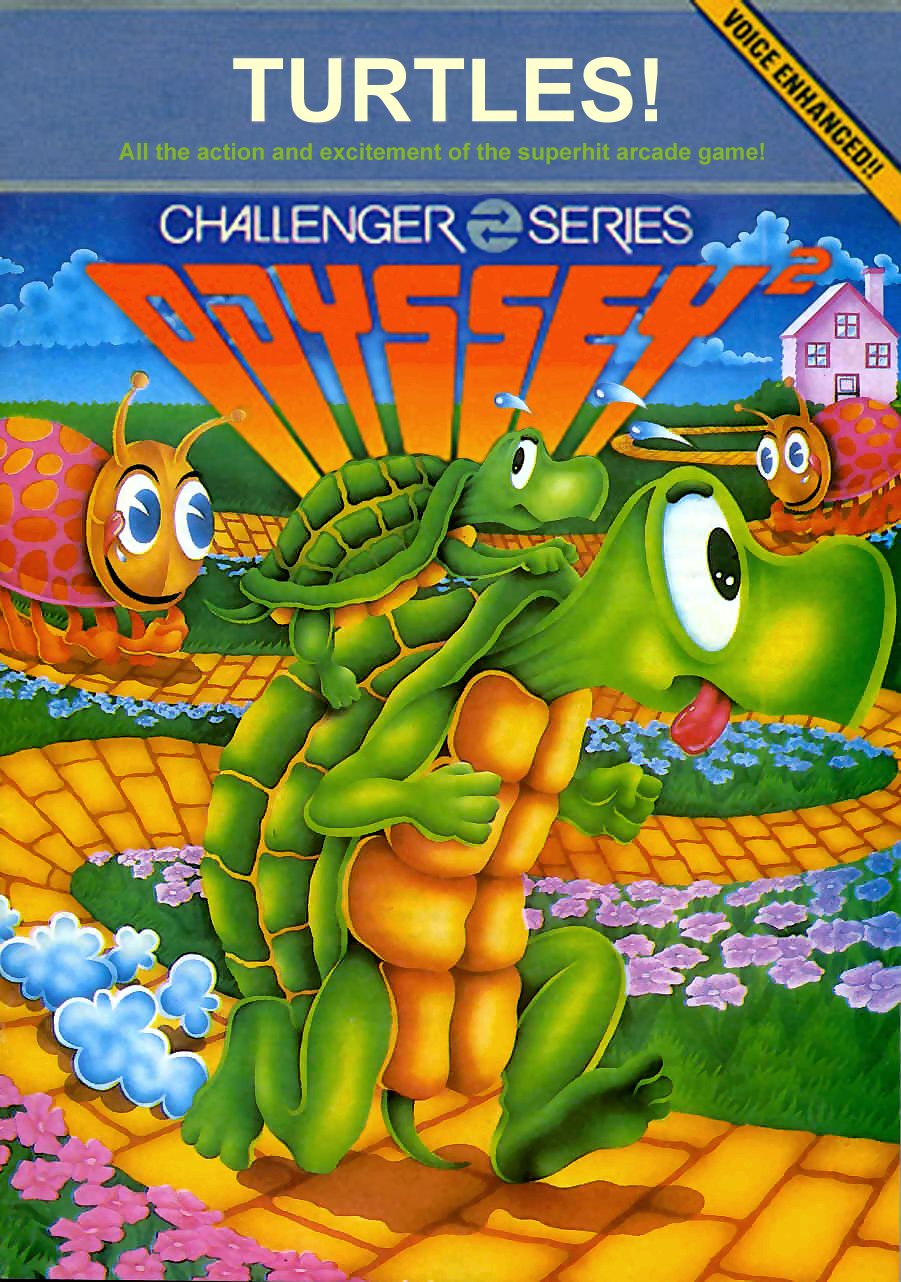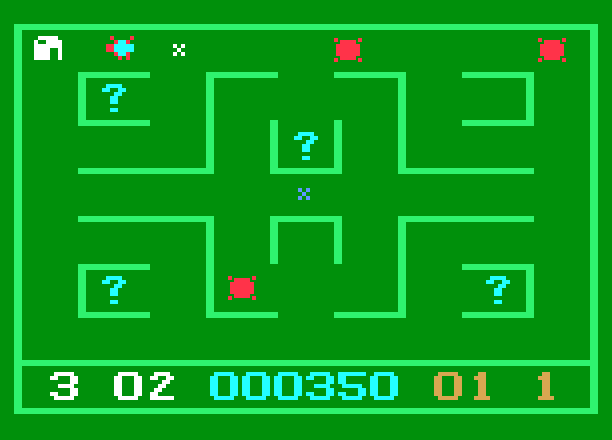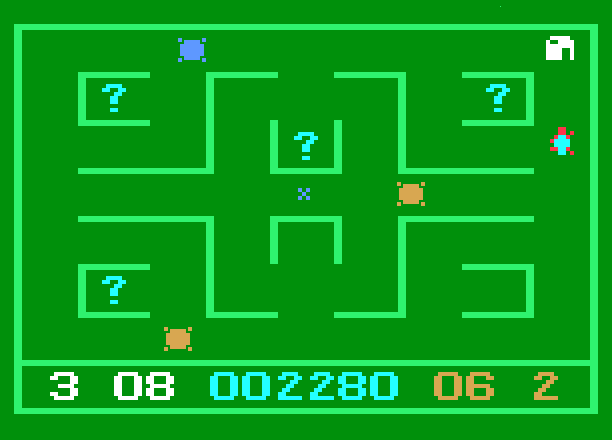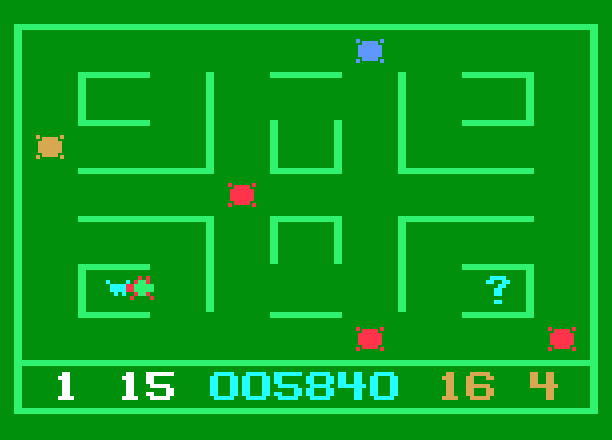Games That You Should Try Again
TURTLES
We once believed that every video game we played had been imagined, programmed and released by a single company: the one whose logo proudly embellished the title screen, cabinet, packaging, etc. The super-brilliant, enigmatic men who worked there had surely met in some huge, echoing room with no visible ceiling and lots of shadows to excitedly contrive its every facet for us like wizards around a jewel-hewing volcano core.
With countless research materials available to us these days (I'm not going to count them, anyway), so much wheat to be stripped from the 'Pedia-level chaff -- not to mention the memories of the wizards themselves -- we've learned that many an arcade or home game came from two or more outfits. Designing and coding teams were often contracted by mere manufacturers; Japanese creations were licensed to western firms, some of which boasted in-house catalogues as well.
You'll accordingly encounter pedigrees that read like the final pages of detective stories: "So you see, everyone, the company called Maganakatonosaki of Japan, maker of marbles and rowboats since 1547, hired Hoyahoya, a team of four men, eight little girls and a parrot, to design Martian Massacre II: Floating Galactic Guts. The programming, however, was carried out in secret at the company's stateside division, Maganakatonosaki of Japan of America. The game was issued in the east as You Blast Good in Super Zoki Zoki Alien! and appeared in the rest of the world under its better known title, having been acquired by Profitable Pastimes of Pennsylvania.
"And why the name change, you ask? PPP had been paid in linen, veal and Chuck E. Cheese gift certificates by Cessco, which produced the Martian Massacre toy line. But that's not all! The home conversion was coded in England by Three Brothers and a Neighbor, but the American conglomerate that actually released it, Kitchen Sinx, took full credit. When it was exported back in cassette form, the Brits were led to believe that it was exclusively a Yanks Make Games product, as none of them had disk drives. Elementary! Thought you could pull a fast one, didn't you, Johnson!"
Now that we have the facts, certain developers shine much more brightly than we would have expected. For instance, it turns out that Konami, which we once wholly associated with the formulaic likes of Gradius, Rush'n Attack and Contra, employed some of the most highly skilled and artistically inspired game-makers of the '80s. Almost any western company that you might care to name obtained the rights to reproduce and distribute one or more of their coin-ops.
The anonymity of most early Konami designers and programmers is a shame, considering the frequently evident brilliance in the Japanese firm's arcade games. Few better examples exist than this 1981 release, a tremendously fun, often disregarded demonstration of originality, balance and addictive appeal.
The original is inexplicably called 600. In the two licensed versions, the cars have become oversized beetles, representing an intriguing evolutionary twist. Sega's game is titled Turpin, an old-fashioned English word that means "land tortoise." Stern Electronics of Chicago's Turtles is virtually identical, even if its name is better known.
Relatively obscure '70s and '80s games (on nearly all platforms) hold special fascination for me. Nostalgia doesn't pertain; loads exist that I didn't even know about back then, and I'm always finding new favorites. They all remain current to me, in a manner of speaking. There's no chronological dividing line drawn through my head, as I've taken no long breaks from playing the "classics" since they were contemporary. Moreover, I love those abstract, beautifully blocky, imagination-inducing graphics. They're unambiguously make-believe, and they evoke an era when creative risks prevailed, new types of interaction were being invented, and game-play triumphed over trimmings.
Speaking of glorious graphical crudity, we'll take a look at the Odyssey2 adaptation a bit later. For now, it bears noting that in spite of its detailed graphics, the coin-op's science-fictiony, non-wasteful angularity lifts it far above its attempted cuteness.
As Papa Turtle, you're on a rescue mission in the beetles' apartment building. The sadly misguided vermin actually believe that they can get away with keeping a bunch of abducted "kidturtles" (as they're called on the title screen) locked inside various studio flats. They're jealous of your tougher shell, you see. Before the game begins, a musical cartoon reveals that a couple of your progeny have stranded themselves on the roof. This doesn't suggest a terribly sharp stab at escaping. They should have climbed downward. Anyway, you appear to be shouting up at them: "Get the hell away from the edge! Are you cracked?"
Canopies crown the front doors of the 600 and Turpin buildings, respectively displaying the Konami and Sega logos (rather audaciously, in the second case). Not being sissies about harsh weather, the Stern guys have left the awning out altogether; but the building itself exhibits a giant, white S. This is pretty crafty, as it can stand for either "Stern" or "Stop that damn music." However, neither possibility explains the P that appears in the other two versions. Hmm. "Play the Stern game instead," perhaps.
So many kids have been snatched that nobody's sure who all the fathers are. I mean, c'mon...they're turtles. They don't keep track of these things. Even so, four of the braver potential Papas have turned up to try saving them. The rest couldn't be bothered. Then again, they travel very slowly, so maybe they're on the way. One arrives when the score reaches 5,000 points, in fact. They're probably all being pestered about it by their women.
You play to the death as each Papa. The building features four different floor plans, each of which is found on two successive stories. Once you've cleared the eighth floor and made it to the roof, you're put through another exterior vignette (now along "Get your damn shells back home!" lines) before you find yourself on another first floor, having noticed that the neighboring building is also crammed with your possible offspring. You've clearly got to sit down with the survivors later and have a chat about why they shouldn't talk with strangers.
Rescue a kid by simply barging into one of the eight rooms on the present floor. Each room is initially obscured by a question mark, so you're oblivious to its contents until you enter, at least before the process of elimination applies. You'll usually find a young turtle, who'll crawl onto your back; but twice per floor, you'll disturb napping beetles (who I call "bedbugs," because I think I'm clever). Be prepared to reverse direction and push the fire button, just in case. This leads us to the subject of laying mines.
Your Papa Turtles share three explosives to begin with, but the beetles, who start as a trio (pending awakened bedbugs), are dumb enough to leave another three in the middle of each floor on a regular basis, stacking them in such a way that they resemble a single large one. The jerks have stolen quite a few from their captives, but they haven't figured out how to arm them. (Young turtles are told never to leave home without mines. Not that it's done any good in this case.)
The beetles call the mines "bug bombs," but the beetles are, if you'll recall, dumb. The devices sure function as land mines (well, carpet mines), so there you go. Pushing the button will drop one behind you, and there it will remain, somehow preventing you from placing another, until a beetle triggers it and finds himself momentarily stunned and immobile. You can crawl right over him, but the other beetles can't. An undetonated mine will magically disappear when you clear the floor or get caught.
Turtles equipped with carpet mines are nothing compared with the weirdness of an entire house materializing inside an apartment building. Regardless, that's exactly what happens when you've fetched a hostage. Dropping him off at home, which appears randomly in one of the corners, frees your shell for the next rescue. The kid's apparently safer in a vanishing villa than a locked flat. And you didn't even know that turtles live in structures just like ours! See, even fun video games can be educational.
That "HELP" indicator above the ammo count should read, "CHILDREN RESCUED THROUGHOUT THE GAME SO FAR," but I guess that would wipe out the remaining-Papas meter, which is found to the left above the floor number. It's great that the last is logged. While playing most any game, I care a lot more about progressing farther than exceeding my prior high score. I have a great memory, but when I care to keep track of conquered levels, doing so while concentrating on the game-play amounts to a preventable chore.
Don't be stingy with the mines; plant one whenever you're being closely pursued. Replacements are plentiful, whereas back-up Papas are not. When you hear a siren noise, you've run out, so plan a safe route to center-screen and step on it (as it were). You can carry as many as you can grab, but the refills, while never unreasonably meager, appear with diminishing frequency over the course of the game. Collect as many as you can on the lower floors.
When you're caught with a kid on your shell, he's not killed. The beetles just send him back to his room. Make that the first stop during your next turn, so you won't forget that it contains a captive rather than a catnapper. Even if you're amply practiced and you can rapidly blast a napper, he'll join the other kidnappers after that and make kid-grabbing a tad more taxing. (Okay. I'll stop.)
Your enemies are initially brown and white -- and myopic. They travel randomly, so when one chases you, it's an accident. After ten seconds, one beetle at a time will mature to orange and green, and develop the ability to spot you across any straight distance. When they're finally blue after another ten seconds, they'll sense you around corners. The intervals dwindle at independent rates; halfway up the first building, for example, the beetles turn orange and green after six seconds and blue after another four. Mine collisions make them each regress to brown and white. They all share your speed and frequently turn around. If you coincidentally rescue all six youngsters without rousing both bedbugs, the floor will count as cleared and you'll advance to the next.
Made it! The upper four floors of each building contain just one bedbug apiece, so four beetles roam each maze from the start. This recurs on the ground floor of every building after the first. A seventh kid has been stuffed into the vacated room.
The catchy but abusively toned music never stops. Thankfully, the sound effects are louder. Still, when I've been playing for a while, I lower the volume quite a bit. I also start to wonder why it's taking so long for the imprisoned turtles to grow up. They're surely big enough to break out by themselves once I've reached the second or third building.
Speaking of arbitrary numbers, 600 doesn't have you transporting tots homeward individually. but rather, recklessly driving through the exit sign that appears in a random corner when your shell's been filled to capacity. Fortunately, you don't have to start the kid-collecting afresh when you've been caught. The automobiles bear individual colors and aggression levels from the beginning. Unlike the bedbugs, the hidden cars are faster than you and your other pursuers. Your mines come from an energy reserve, which can't be manually replenished; it regenerates over time (more slowly as the game goes on) and starts full on each new floor.
The fact that the beetles are driving indoors shows how moronic they truly are. Notwithstanding the race-car graphics, it's entirely possible that the Konami folks who changed the game for Sega and Stern misunderstood what a Volkswagen Beetle was.
As with a few other Stern games, including Frenzy -- but not, curiously, its precursor Berzerk -- the Turtles marquee actually reads "Stern / Seeburg." The latter company, primarily a jukebox manufacturer, was founded in 1902 (and owned Williams Electronics from '64 to '79, incidentally). When it closed after 77 years, its remaining stock was bought by Stern, whose arcade involvement was still limited to pinball tables. "Stern / Seeburg" became synonymous with "Stern Electronics of Chicago." S / S jukeboxes were distributed until '84, when the whole business went bankrupt and its pertinent properties were purchased by the newly formed Seeburg Phonograph Company, whose investors were led by a '70s Seeburg employee. In '86, SPC made the first compact-disc jukebox.
The Philips Videopac and North-American Philips / Magnavox Odyssey2 game [taking a breath] was programmed -- very, very well -- by Jim Butler. It was made available to Europeans in late '82 and Americans in April of '83. It's the only coin-op conversion by Philips itself, and it's easily the best issued by any company for the sibling consoles.
The first thing to find alluring is that someone has finally turned off the stereo, making the building quiet enough to facilitate focus on the game-play. The sounds themselves are essential to any game's visceral impact. This is why I'm not crazy about the Atari 2600's Parker Brothers version ('84) of Konami and Centuri's Gyruss coin-op ('83), to name just one music-only game. Granted, Papa Turtle's footfalls are now incessant; but at least they reflect the player's actions, rather than serving merely as aural wallpaper like the arcade music.
The manual refers to the setting as the Turtle-Towers Hotel, but I still think of it as the beetles' apartment building, since they've obviously taken the place over. Besides, what would the adjacent buildings be called? The Turtle-Towers Hotel II, III, etc.? Get real! The giant bugs have clearly overrun a district of residential high-rises.
Each floor contains only six apartments and one napper (called a "deadly-beetle egg" in the manual, but turtles can't possibly induce insect hatching, at least so swiftly); the beetles are blue, yellow and finally red; they mature through these carapaces much more rapidly; they never reverse direction unless they encounter each other; and you all travel faster. These are the only major differences.
Butler was sharp enough to make use of the console's strengths and offset its limitations, even while re-coding arcade games. He also programmed P.T. Barnum's Acrobats (called Jumping Acrobats for its European -- i.e. Videopac -- release), which was Philips's requisite rip-off of Exidy's Circus coin-op from '77.
Along with my other O2 favorites, Killer Bees and the two K.C. installments, Turtles makes me wonder what else might have turned up if the system had been kept alive longer and its technical boundaries had been pushed further (cf. the overall Atari 2600 catalogue).
Certainly, there are other, purely cosmetic differences. You still climb from floor to floor on fire-escape ladders, but you're spared the intermissions between buildings. You set out from the lower right corner instead of the left, and the siren noise has become a low beeping. The screen is now horizontal, but it hardly matters in this game; you needn't change your tactics as much as in, say, perpendicular Pac-Man.
The combination of green and greener is particular to this version, but it's agreeable and unobtrusive. The coin-op's music plays when Philips's U.S.-only Voice of Odyssey2 component is in use, so do yourself a favor and leave it unattached.
On account of an O2 variable restriction, no more than 99 mines can be planted during the whole game. I've never bumped into this limit, so I don't care. Most significantly, the fluidity, controller responsiveness and collision detection are all just as sound as in the arcade edition. It could almost be mistaken for an Atari 2600 game.
While the screen exhibits the same information, the sequence is different: back-up Papa Turtles, remaining ammo, score, rescued kids and current floor number. Curiously, the fifth and seventh floors each contain two snoozing beetles. The upper two layouts are especially tricky, thanks to their dead-end apartments; you're all the more advised to stock up on mines in advance.
The scoring is identical to the coin-op's, and an extra Papa Turtle duly arrives at 5,000 points. It should have been changed to every 5,000, as quarter-munching no longer pertains. Considering which console we're talking about, however, it's just nice to get more than one "life."
Even when arcade translations aren't -- or simply can't be -- substantially accurate, they can be watertight and equally enjoyable. I just view them as separate games, albeit with (usually) matching titles.
Those that are faithful doubly impress when even the same strategies apply, as they do in the case of these eight great kilobytes.
The instant either game begins, hasten from apartment to house to apartment, tenaciously liberating and depositing kids. Deviate only when survival demands it; blast beetles along the way (particularly when you're about to be followed into a flat), rather than trying to waylay them for points -- even if you're primarily hoping to score high. Rescues are worth much more than insect injuries.
There's one exception to the direct routing recommended above: Swerve to grab more ammo from the center whenever you're obliged to cross the playfield. Take into account that you, unlike your adversaries, are smart enough to step over a mine without triggering it.
When you've been caught for the last time, by all means, start over, dispense with the tactics and take your revenge. Don't let anybody get away with killing one of your mighty Game Land incarnations. Scare those dung beetles by coming back to life and flooding the building with your resonant voice: "I might be a turtle, but I'm still fast enough to arrange for your permanent stays at the PAIN HOTEL!" Then throw in an evil laugh. And stop telling me that I need to get out more.
Each beetle's crawling animation comprises two quickly alternating frames. These screen shots combine them, as the clever flickering-legs effect can't be conveyed with still pictures. Happily, there's no implied grid dictating your movement, as there is in each K.C. game; you can move freely around each maze, rather than merely from position to position.
I'm aware, by the way, that most of the game titles in this article are meant to be hollered, so long as one heeds the exclamation points on all first-party Odyssey2 boxes and manual covers (but not, inconsistently enough, all cartridges -- or any Videopac-aging at all, for that matter). I'll explain the more conversational level I've generally maintained.
It's easily verified that there's no punctuation in the arcade name Turtles; but there's none in any of the home titles above, either. We've only to consult the opening screens, as these reflect the programmers' intentions. While I'm at it, other correct names, including the spaces, are Battle Zone, Sprint Master, BMX Air Master and Lady Bug. This paragraph isn't terribly important, of course, but you've reached the end of it, so I'm afraid you're stuck with it.
Turtles adaptations also came out for the Emerson Arcadia 2001 and Entex Adventure Vision consoles. On the former, the title screen puzzlingly bears both names (Turtles and Turpin). The irony is that the game is actually a conversion of 600.
Whether you've briefly tried out the remarkable O2 rendition, the coin-op or neither, they're both more fun than you probably think. If you give yourself time to get the hang of the game-play, you'll most likely find yourself hooked.
In Turtles II: Shell Games, which remains unreleased everywhere except in my head, you finally get to hunt down the landlord and find out what kind of nutcase rents an entire block of buildings to a bunch of giant bugs.
